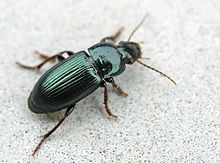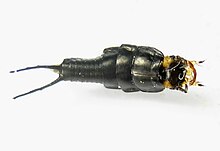Harpalinae
| Harpalinae | |
|---|---|

| |
| Harpalus pensylvanicus, a member of the Harpalinae subfamily. | |
| Scientific classification | |
| Domain: | Eukaryota |
| Kingdom: | Animalia |
| Phylum: | Arthropoda |
| Class: | Insecta |
| Order: | Coleoptera |
| Family: | Carabidae |
| Subfamily: | Harpalinae Linnaeus, 1758 |
Harpalinae is the largest subfamily of ground beetles, containing more than 19,000 species worldwide.[1]



Biology
This subfamily contains the most
Systematics
Recent phylogenetic analysis of Harpalinae has placed approximately 19,000 species within around 40 tribes in this subfamily
Fossil record
Fossil records and evolutionary history show that tribes within Harpalinae likely arose and diversified during the mid-Cretaceous period. A first fossil of a member of Harpalinae was dated to be from the late-Cretaceous period, and extant species of Harpalinae were found in Baltic amber.[1][6]
Ecology
Members of Harpalinae fulfill a variety of ecological niches. These include various symbioses with other insects, ovoviviparity, and even ectoparasitism.[6] Harpaline beetles, like other ground beetles, have pygidial glands that are used for defensive secretions, some secretions containing formic acid.[7] Members of Harpalinae are even considered agents of biological pest control, especially in agricultural settings.[8][9] While likely not having co-evolved with the angiosperms, angiosperm radiation likely lead to the diversification of ecological niches in Harpalinae.[4]
Tribes
The subfamily Harpalinae contains around 40 tribes, consisting of 19,000 species worldwide.



- Abacetini Chaudoir, 1872
- Anisodactylini Lacordaire, 1854
- Anthiini Bonelli, 1813
- Caelostomini Lorenz, 1998, Liebherr 1986
- Calophaenini Laporte, 1834
- Catapieseini
- Chlaeniini Brullé, 1834
- Cnemalobini Germain, 1911
- Ctenodactylini
- Cyclosomini Laporte, 1834
- Dercylini
- Dryptini Bonelli, 1810
- Galeritini
- Graphipterini Latreille, 1802
- Harpalini Bonelli, 1810
- Helluonini
- Hexagoniini
- Lachnophorini Leconte, 1853
- Lebiini Bonelli, 1810
- Licinini Bonelli, 1810
- Loxandrini Erwin & Sims, 1984
- Morionini
- Odacanthini Laporte, 1834
- Oodini Laferté-Sénectère, 1851
- Orthogoniini
- Panagaeini Bonelli, 1810
- Peleciini Chaudoir, 1880
- Pelmatellini Bates, 1882
- Pentagonicini Bates, 1873
- Perigonini Horn, 1881
- Physocrotaphini
- Platynini Bonelli, 1810
- Pseudomorphini Newman, 1842
- Pterostichini Bonelli, 1810
- Stenolophini Kirby, 1837
- Zabrini Bonelli, 1810
- Zuphiini Bonelli, 1810
